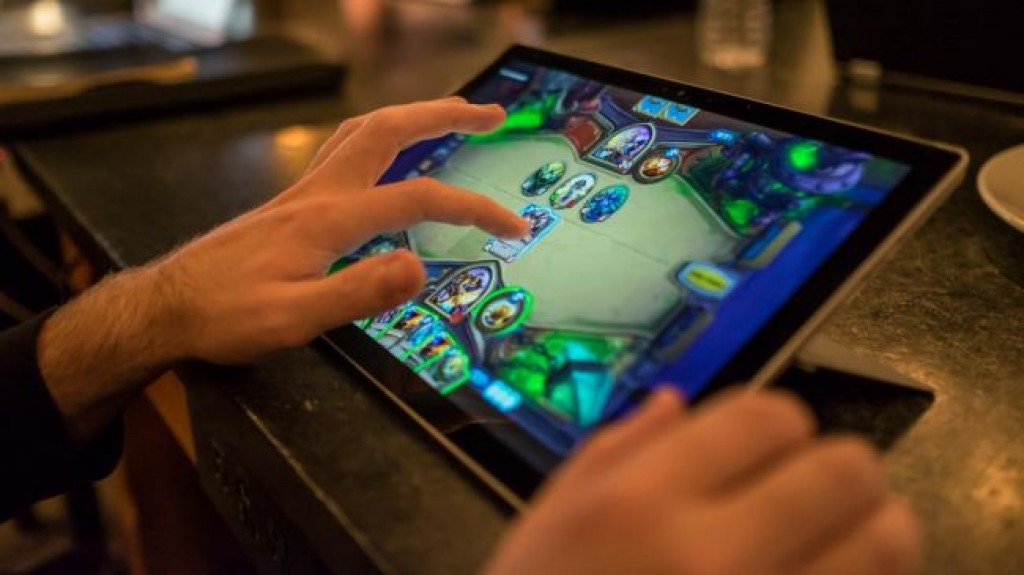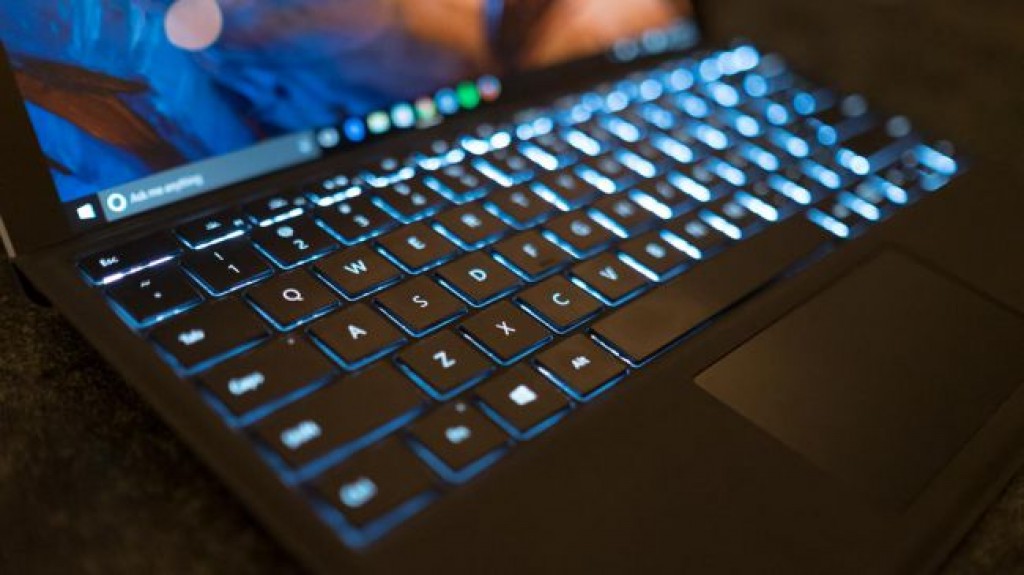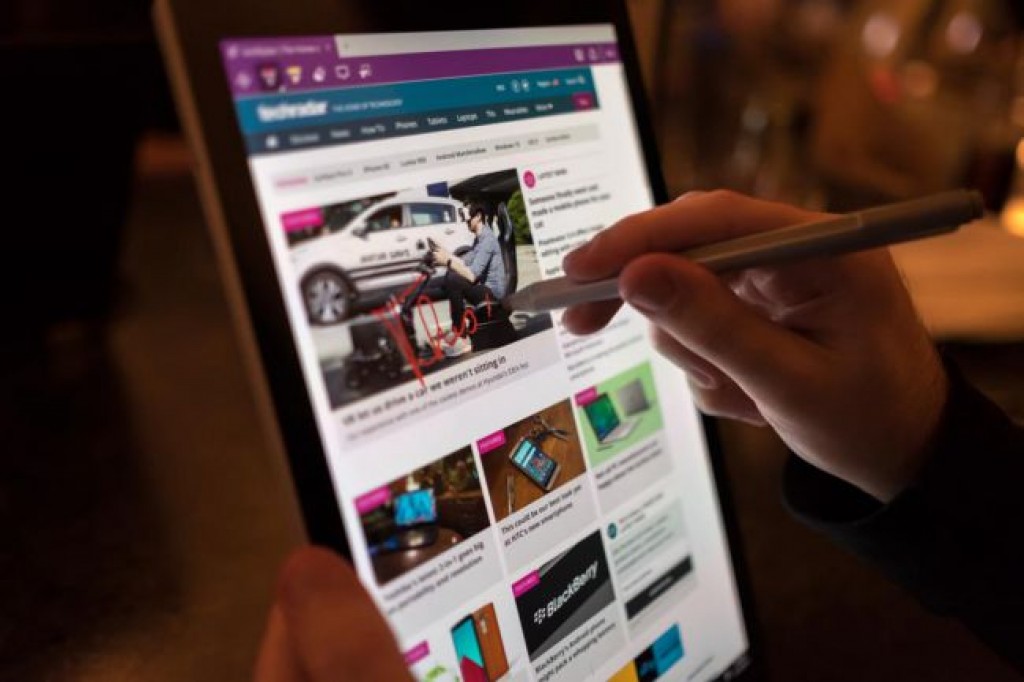
OUR VERDICT
Has Microsoft at last crafted a tablet that can reasonably, without considerable compromise, replace your laptop? Short of going back to the drawing board on the battery, this looks as close as it’s going to get.
FOR
- Larger, sharper screen within same dimensions
- Vastly improved Type Cover
- Even better Surface Pen
AGAINST
- Type Cover still sold separately
- Intel Core m3 at entry level
- Battery life hasn’t improved much
Microsoft Surface Pro 4: The Essential Review
Our ‘essential review’ of the Surface Pro 4 contains all of the highlights (and lowlights) of Microsoft’s 2015 Windows 10 tablet. It’s intended as a more digestible summary of our full-length review, in that it shouldn’t take more than half a minute to read.
While it was officially succeeded by the Surface Pro 2017 – which itself has now been succeeded by the Surface Pro 6 – the Surface Pro 4 is still worth your time, even in 2018. This is because, when it was first launched back in October 2015, the Surface Pro 4 was praised as the natural progression of the Surface Pro heritage.
When the Surface Pro 4 hit the market, it featured more levels of pressure sensitivity and a ton of new hardware buttons to the signature, but sold separately, Surface Pen. The Type Cover was also heavier and more satisfying to the touch, while the screen resolution was given a massive boost to 2,736 x 1,824 – a boost to 216 ppi, as opposed to the MacBook Air’s 128.
The Surface Pro 4 endures the test of time, and it’s even still getting support – Microsoft is still replacing faulty Surface Pro 4 devices even in the face of the new Surface Pro 6. And, unlike the Surface Pro 3, which ran Windows 8.1, the Surface Pro 4 natively supports Windows 10. This is a major improvement, considering all the things Windows 10 can do.
Microsoft put a lot of attention into perfecting the design of the Surface Pro 4, rather than reinventing the wheel. So, the Surface Pro 4 has a very similar look and feel to that of the Surface Pro 3, with some minor improvements – including a new chrome-laden Microsoft logo and more than half a millimeter thinner than the previous generation.
Microsoft Surface Pro 4: Who’s it for? Should I buy it?
If you’re not into the gigantic size, not to mention price, of the Surface Book 2, the Surface Pro 4 isn’t just a worthy alternative, but an excellent first choice for creative professionals that are always moving around. It costs less than the new Surface Pro 6 if you buy it refurbished, and we’re sure a ton of Black Friday and Cyber Monday deals will make it even cheaper.
Although there are admittedly shortcomings when it comes to the battery life of the Surface Pro 4, it still holds up as a product that we can safely recommend to Windows tablet newcomers and veterans alike. As a ‘Pro’ device, the Surface Pro 4, of course, ships with Windows 10 Pro pre-installed (a $199/£219/AU$339 value).
That goes without mentioning the Surface Pro 4’s gorgeous screen, which is crystal clear when pitted up against its predecessor. The Type Cover might be sold separately, too, but it’s satisfying to the touch nonetheless. As we glossed over before, the battery life lasting only 3 hours and 15 minutes in the PCMark 8 test is pretty unacceptable for a tablet, but the zippy internal components more than make up for the frequent need to charge.
And, thanks to its dramatically lower pricing, the Surface Pro 4 is bound to retain a dedicated audience well into the future.
At the end of the day, the Surface Pro 4 is markedly cheaper and better than its recently released ARM-based rivals. Now that the the HP Envy x2 is available for sale, you may have anticipated a lower starting price than that of Microsoft’s tablets due to its use of the Qualcomm Snapdragon 835 processor found in a lot of Android phones these days.
Unfortunately, it’s far more expensive. For the time being, you’re better off picking up the Asus NovaGo if LTE functionality at a low price is what you’re after. Meanwhile, the Surface Pro 4 is $50 less than the NovaGo and features twice the storage and more powerful specs.

Design and display
Just like last time, the same all-magnesium, uni-body casing is still here, though the ‘Surface’ logo has been replaced with Microsoft’s new logo in chrome.
Microsoft boosted the Surface Pro 4’s display size by a few hairs, from 12 inches to 12.3 inches, without affecting the device’s footprint. In fact, the company shaved more than half a millimeter off of its thickness, from 9.1mm to 8.4mm – all while including full-fat mobile U-series processors.
As for how this was done, the capacitive Windows button said goodbye, thus the extra room for that three tenths of an inch in the display.
Then, Microsoft brought the screen’s optical stack – the series of sensors, diodes and pixels beneath the glass – even closer to the glass now, a key point of Microsoft’s trademarked PixelSense screen technology.
The display is thus incredibly responsive to touch, and the further sensitivity it brings to the stylus experience is huge. In tandem with the improved Surface Pen, the screen detects 1,024 levels of pressure, even during a single stroke.

Now, let’s talk resolution. Even though it didn’t have to, Microsoft increased the Surface Pro 4’s resolution from 2,160 x 1,440 (216 ppi, or pixels per inch) to 2,736 x 1,824. That makes for a huge 267 ppi for the Surface Pro 4, which blows a key rival, the MacBook Air (128 ppi for the 13-inch), out of the water and just barely beating out out Apple’s 12.9-inch iPad Pro at 264 ppi.
More importantly, the new screen proves to be way more luminous and more color accurate than the Surface Pro 3 display at all brightness levels. This is obviously going to be a pretty big deal for any designers or artists that are looking to upgrade from the Wacom tablet and calibrated monitor combo.

For the rest of us, this means more realistic-looking movies and more vibrant photos and games. That’s despite even thicker black bars sandwiching your favorite films in 16:9 – and even more so for those in 21:9, or widescreen format, thanks to the 3:2 aspect ratio that remains from last generation.
It’s a fair concern for folks that watch plenty of movies and TV on a tablet. But fear not, workers, for you’re the very reason Microsoft made this decision. The 3:2 aspect ratio is a middle ground between 16:9 and 4:3 that is ideal for both photo and design or drafting work, wherein 3:2 is much more common, as well as getting computational work done, given the extra vertical space.

Surface Pen and Type Cover
In addition to the aforementioned 1,024 levels of pressure sensitivity, the new-and-included Surface Pen is redesigned to feel more like a pencil. The stylus now has one flat side, as if a Number 2 pencil had all but two of its angles rounded off.
This version is even more comfortable to hold than the last as a result – your index finger rests just above the main function button on the flat end. Secondly, the left side of the frame is coated with thin, powerful strip magnets that allow it to cling onto the tablet’s left side. The age of stylus loops is over.

When the Surface Pen is paired with Microsoft’s PixelSense display, the combination results in the best stylus experience we’ve had on a tablet for as little as we’re likely to actually use it. While we’re neither artists nor designers, the screen’s superb palm detection and the accuracy and nuance of the Pen tracking gives us confidence that the Surface Pro 4 is Microsoft’s best shot at luring in that crowd yet.

Coupled with Microsoft’s PixelSense display, the duo makes for the best stylus experience we’ve had on a tablet yet for as little as we’re wont to use it. While we’re neither artists nor designers, the screen’s superb palm detection and the accuracy and nuance of the Pen tracking give us confidence that the Surface Pro 4 is Microsoft’s best shot at luring in that crowd yet.

These improvements pale in comparison with Microsoft’s new-and-still-not-included Type Cover. This time around, Microsoft took a chiclet-style approach. This makes keeping track of which keys your fingers are on by feel much easier, and it allows for each key to be individually back lit.
The new Type Cover is also thicker and far more rigid than before, allowing for deeper key travel and punchier feedback – not to mention a sturdier, quieter surface to type on – that brings it so much closer to a true laptop keyboard. Microsoft also widened the touchpad and coated it in glass rather than plastic.

Finally, Microsoft has a version of the Type Cover with a biometric Fingerprint ID for $159 (£149, AU$249). The new keyboard cover is only available in black and uses Windows Hello to login to the Surface with a fingertip press. The scanner can also authorise app purchases from the Windows Store, and because the keyboard is backwards compatible, it can be used with the Surface Pro 3 too.
Performance
Every performance score here, save for PCMark 8 Home, shows a minor increase from the first unit I tested. It’s a good sign that the Surface Pro 4 was already operating at its peak, except for a battery needed fixing.
The Surface Pro 4 beat out the 2015 HP Spectre x360 in nearly every test by about 25%. As for the 13-inch MacBook Air, its multi-core Geekbench 3 (which tests processors primarily) score is way short of what the Surface Pro 4 reached.
If you’re curious, the Surface Pro 4 runs Hearthstone (our de facto tablet game) without breaking a sweat at the highest settings – even at an automatically adapted resolution. Plus, the color-calibrated display makes every part of Hearthstone’s play area that much more distracting.
When all is said and done, there isn’t a major difference between the Surface Pro 4 and the other competitors we mentioned when it comes to everyday performance, though the Macbook Air will last longer on a charge. If anything, you get slightly better gaming performance on the Surface Pro 4 than the 2015 Spectre x360, but neither are gaming devices.

Battery life
Tested on pre-production hardware that we were promised has been scrubbed of its battery woes, the Surface Pro 4 produced far better battery life results than at the onset. Unfortunately, they’re still well below not only Microsoft’s own claims, but what choice rivals are able to put up.
While arguably the most harsh battery test in our lineup, PCMark 8 Home Battery saw the Pro 4 last 3 hours and 15 minutes, a marked 50% increase from before. Still, the Spectre x360 held out in that test for 4 hours and 38 minutes.

Microsoft’s tablet fared much better on our video playback test, lasting 5 hours and 15 minutes. That’s enough to last you on most coast-to-coast US flights.
In a similar test, the MacBook Air was able to stream 1080p video over Wi-Fi for a whopping 13 hours and 24 minutes. Though, that’s thanks to a far lower-resolution display and likely a larger battery.
Regardless, Microsoft promises up to 9 hours of video playback, and these numbers aren’t close. Sure, these figures are far better than last year’s Surface Pro 3, despite the serious screen resolution bump, which should not be overlooked. But, they still can’t hold a candle to neither Apple’s leading laptop nor its top tablet – much less comparable Windows hybrids.
Longevity is then about the only thing holding the Surface Pro 4 back from truly, honestly replacing your laptop – or at least your MacBook Air specifically. Otherwise, the machine offers somewhat below-average lasting power.
Source: techradar.com









































